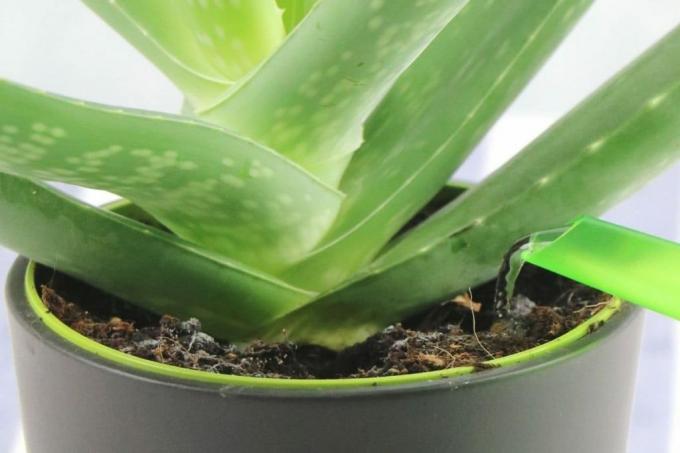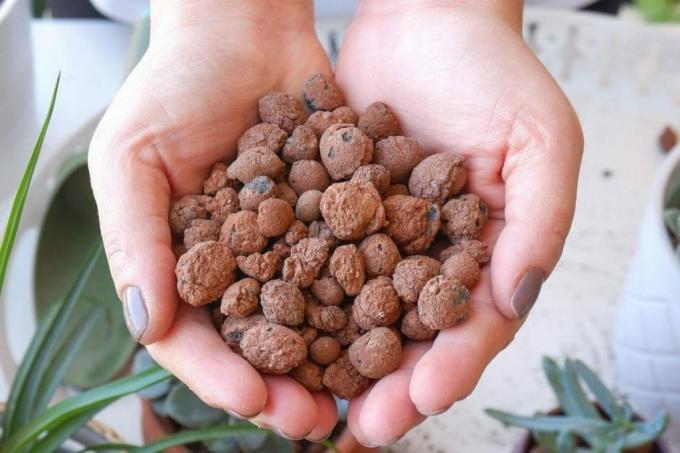
table of contents
- Aloe vera
- 6 tips for watering
- Aloe Vera in hydroponics
- frequently asked Questions
The juice of the Aloe vera forms the basis for healing and care products. As a houseplant, the plant with its thick-fleshed leaves is very popular. When and how often does real aloe have to be watered?
In a nutshell
- Aloe comes from the warm and sunny Mediterranean region
- Avoid waterlogging
- Do not wet leaves with water
- Note water hardness and lime content
- Hydroponics recommended
Aloe vera
Aloe vera comes from the Mediterranean region. she loves warmth and sun. Aloe has been used as a medicinal plant for centuries. The juice that is extracted from its leaves is considered a remedy and beauty elixir.
In this country it is popular as a houseplant. Its thick-fleshed leaves, framed with thorns, are arranged in a rosette. At the beginning of the year, the extravagant inflorescence appears. Orange, yellow or white tubular flowers are arranged around a vertical, barely branched flower stalk.
In order for aloe vera to produce strong leaves and beautiful flowers, it needs a suitable location and some care. If you want to cultivate it in the apartment or on the balcony, you should consider the special requirements of the aloe when watering.
6 tips for watering
Avoid waterlogging
All succulents, including aloe, are sensitive to waterlogging. Pour the substrate penetrating. Immediately afterwards, remove excess water from the trivet.
Tip: Good drainage will reduce this Risk of putrefaction due to waterlogging. We recommend a thick drainage layer made of potsherds and gravel.
Do not wet leaves with water

The thick aloe leaves must not be wetted with water. Only water the substrate. Place potted plants on balconies and terraces protected from rain.
Pour little
The real aloe stores moisture in its thick leaves. It can survive longer periods of drought. How often it has to be watered depends on the condition of the substrate surface. During the growing season, always water when the top layer is dry. It is not necessary to give more than one or two waterings per week. In winter, when the aloe is in a cool place, no watering is necessary.
Tip: A cool overwintering has a beneficial effect on the flowering of the aloe.
Use low-lime irrigation water
The extravagant houseplant is sensitive to calcareous water. Check the calcium content of the drinking water in the region. It is best to use rainwater to water the aloe.
Note the point in time
The best time to water the aloe is in the morning.
Use suitable substrate
the Risk of waterlogging can be reduced by using a permeable substrate. We recommend a nutrient-poor, calcareous, sandy substrate.
Aloe Vera in hydroponics
In order to avoid any problems when watering the aloe, hydroponics is recommended as an alternative. It is perfect for aloes that are sensitive to waterlogging and whose leaves must not be wetted with water. The optimal supply of water and nutrients is ensured in modern hydroponic systems.

Advantages of hydroponics:
- Long-term water storage
- Release of moisture as required
- Prevention of waterlogging
- optimal nutrient supply
frequently asked Questions
Red discoloration of the leaf tips is a sign of a lack of moisture. Water your plant weekly in spring and summer. Check the dryness of the substrate surface with your finger.
It is not necessary to spray the leaves of the aloe with water. It can damage the plant, especially on cool days when quick drying is not guaranteed. Only spray the aloe on warm and dry days to remove dust from the leaves.
Aloe vera can easily be propagated by cuttings. The small plants cannot store much moisture in their leaves and are dependent on regular watering. Water the young plants twice a week. Remove the water from the planter or saucer to prevent waterlogging.
Even in winter, hydroponics do an excellent job of meeting the needs of the plant. Put the aloe in a cool, not too bright place. Photosynthesis is shut down and the houseplant draws strength for the next spring.
